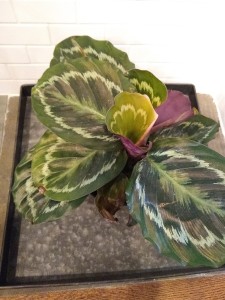 House plants are all the rage, in North America and abroad. Shelter magazine photographers are working overtime trying to get shots of everything from begonias to banana trees. Pinterest is full of luxurious tropical plants. Horticulture publications that used to treat house plants as afterthoughts now devote entire sections, or sometimes entire issues to indoor horticulture. Even the grand old journal of the Royal Horticultural Society, The Garden, has made house plants the focus of its January edition. One story features a man who grows over 100 thriving specimens in a southeast London loft. The article’s author terms it “an exotic live-in jungle.”
House plants are all the rage, in North America and abroad. Shelter magazine photographers are working overtime trying to get shots of everything from begonias to banana trees. Pinterest is full of luxurious tropical plants. Horticulture publications that used to treat house plants as afterthoughts now devote entire sections, or sometimes entire issues to indoor horticulture. Even the grand old journal of the Royal Horticultural Society, The Garden, has made house plants the focus of its January edition. One story features a man who grows over 100 thriving specimens in a southeast London loft. The article’s author terms it “an exotic live-in jungle.”
While plenty of house plants flower, the vast majority of specimens featured in fulsome magazine and internet spreads are foliage plants. People use them as decorative accents or group them together to create calming green oases.
I need calm as much as the next person, but I must have some color—other than green—in my life. If I am going to invest time, energy and space to a foliage specimen, it must have something to offer in addition to interesting form.
That is why last week, in a fit of houseplant madness, I bought a calathea.
You may have seen calathea in the house plant areas of nurseries or garden centers. They may also show up in big-box stores, especially at this time of year, before the outdoor gardening plants and supplies take over. Different calathea species come in an array of sizes, but the commercially available varieties all bear beautifully striped or patterned leaves.
The plant that stole my heart is a variety of Calathea makoyana or peacock plant. It stands about fourteen inches tall, from the base of the nursery pot to the top of the tallest leaf, and about the same width. Several stalks emerge from the plant’s base, giving rise to leaves that start out tightly furled, like a slender umbrella. They unwind gradually to reveal large, ovoid leaves that appear to have been painted in a symmetrical pattern that alternates several shades of darker and lighter green. The undersides of those leaves, which also have slightly wavy edges, are a warm, brownish maroon. Though the “peacock plant” does not feature peacock colors, it is as showy as the bird’s tail feathers.
The genus name, “calathea” is derived from a Latin word, “calathus”, which means “basket”. Supposedly when the plants produce flowers, they resemble flower-filled baskets. This may be true of some species, but I will never be able to judge that with my peacock plant. Like many tropicals that do not spend their lives outdoors or under greenhouse conditions, it rarely flowers. The Missouri Botanical Garden’s authoritative website also advises that the peacock plant’s purple and white flowers are “insignificant”. While it would be lovely to have a flower basket for a few days or weeks, foliage is the big attraction of these plants.
I have seen all kinds of calatheas, including gorgeous peacock plants, in botanical institutions like Longwood Gardens and the New York Botanical Garden. They spend their lives in glass houses where conditions mimic those of their home areas in Brazil and elsewhere in South America. If you are lucky enough to have a greenhouse, you can do the same thing. The rest of us can position our personal peacocks indoors in locations where they will receive bright, indirect light. Water when the surface of the soil feels dry, but provide the humidity the plant craves by positioning the pot atop a shallow tray filled with pebbles and water. Fertilize during the active growth season—spring through late fall—with a balanced fertilizer, diluted or applied according to package directions. If you are able to give your calathea a summer vacation on your porch or terrace, or in your garden, make sure it stays in light shade. Too much sun will burn the beautiful leaves.
If you love the “peacock” foliage of Calathea makoyana, you may also covet its relatives Calathea lancifolia or rattlesnake plant; Calathea zebrina, also known as zebra plant; and Calathea ornata, the pinstripe plant. Both the lancifolia and zebrina species feature foliage that is somewhat longer and narrower than the rounded leaves of my peacock plant. The ornata species falls somewhere in between, with wide, rounded leaves that are pointed at the ends. Zebra plant foliage is adorned with dark green zebra-like bands, while pinstripe plants feature thin yellow stripes on each leaf. Rattlesnake plant leaves bear alternating splotches of dark and light green. All of these highly decorative species have cultural requirements similar to those of the peacock plant.
Even those of us who love tropical plants probably won’t emulate the Londoner with the indoor jungle. Time and space considerations require that most of us be a bit more choosey about our house plants. In that situation, calatheas are an excellent choice, providing lots of visual interest in exchange for relatively little care.
Local nurseries and garden centers usually stock calatheas in their tropical plant sections. For an online vendor try Logees, 141 North Street, Danielson, CT 06239; (860) 774-8038; www.logees.com. Free print catalog.
